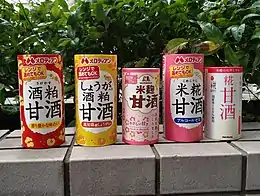Amazake
Amazake (甘酒, [amazake]) is a traditional sweet, low-alcohol Japanese drink made from fermented rice. Amazake dates from the Kofun period, and it is mentioned in the Nihon Shoki. It is part of the family of traditional Japanese foods made using the koji mold Aspergillus oryzae (麹, kōji), which also includes miso, soy sauce, and sake.[1][2]
 A cup of amazake | |
| Type | Plant milk |
|---|---|
| Course | Drink |
| Place of origin | Japan |
| Region or state | East Asia |
| Associated national cuisine | Japanese cuisine |
| Created by | Kofun period in Japan |
| Serving temperature | Warm, room temperature, or cold |
| Main ingredients | Fermented rice |

There are several recipes for amazake that have been used for hundreds of years. By a popular recipe, kōji is added to cooled whole grain rice causing enzymes to break down the carbohydrates into simpler unrefined sugars. As the mixture incubates, sweetness develops naturally.[3] By another popular recipe, sake kasu is simply mixed with water, but usually sugar is added.
Amazake can be used as a dessert, snack, natural sweetening agent, baby food, salad dressing or smoothie. The traditional drink (prepared by combining amazake and water, heated to a simmer, and often topped with a pinch of finely grated ginger) was popular with street vendors, and it is still served at inns, teahouses,[4] and at festivals. Many Shinto shrines provide or sell it in the New Year. In the 20th century, an instant version became available.
Amazake is believed to be very nutritious. It contains vitamin B1, B2, B6, folic acid, dietary fiber, oligosaccharide, cysteine, arginine and glutamine.[5] It is often considered a hangover cure in Japan.[6] Outside Japan, it is often sold in Asian grocery stores during the winter months, and, all year round, in natural food stores in the U.S. and Europe, as a beverage and natural sweetener.
Similar beverages include the Chinese jiuniang and Korean gamju. In grape winemaking, must – sweet, thick, unfermented grape juice – is a similar product.
See also
- Brown rice syrup
- Choujiu
- Gamju – Korean equivalent of Amazake
- Jiuniang – Chinese equivalent of Amazake
- Must – similar product in winemaking
- Rice milk
- Rice pudding
- Small beer
- Sikhye
References
- Shurtleff, W.; Aoyagi. A. 1988. Amazake and Amazake Frozen Desserts. Lafayette, California: Soyfoods Center. 69 + [52] pp.
- Shurtleff, W.; Aoyagi, A. 2012. History of Koji – Grains and/or Soybeans Enrobed in a Mold Culture (300 BCE to 2012). Lafayette, California. 660 pp. (1,560 refs, 142 historical illustrations and photos, free on the Web)
- "Amazake-Sweet Ambrosia". Mitoku. Retrieved 23 January 2010.
- "Amazake". About.com. Archived from the original on 16 July 2011. Retrieved 23 January 2010.
- Belleme, John; Jan Belleme (2007). Japanese Foods That Heal. Tuttle Publishing. pp. 55–58. ISBN 978-0-8048-3594-7. Retrieved 13 May 2008.
- "Restaurant Amazake in Hong Kong". www.diningcity.cn. DiningCity. Archived from the original on 31 December 2014. Retrieved 30 December 2014.
External links
 Media related to Amazake at Wikimedia Commons
Media related to Amazake at Wikimedia Commons